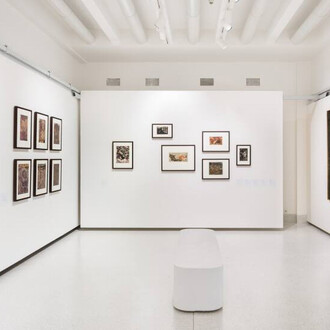Chapter 8th of the Moving Image Department presents Lassnig as an experimental filmmaker. In the 1970s, film became a significant part of her artistic practice which had been focused mainly on painting. Considered the grande dame of Austrian animation film, Lassnig studied animation at the New York School of Visual Arts during her stay in New York (1968-1980) which she would characterize as one of the most vital chapters in her life and career. As a member of the Women/Artists/Filmmakers, Inc., the feminist avant-garde group which she co-founded in 1974 together with Martha Edelheit, Doris Chase, Carolee Schneemann, Rosalind Schneider, Silvianna Goldsmith, Nancy Kendall, Susan Brockman, Alida Walsh and Olga Spiegel, Lassnig made a number of animated films between 1970 and 1976 that contain autobiographical elements, dealing with women’s role in society and the increasing intrusion of technology in our lives, in a playful way.
Lassnig studied animation at a time when she struggled for a recognition as a painter. However, she did not think of this practice as separate from painting, and her work with animation seems to have contributed to some of the radical changes in style that happened during her time in the USA. In the experimental film milieu, she found kindred spirits with similar ideas, and she met with more understanding from filmmakers than from the art world. Her filmic oeuvre emerged from such nascent energies of women experimental interdisciplinarians who were using moving pictures to articulate their visions, many of which featured themes of independence, power struggle, and eroticism in the 1970s New York and European art worlds.
Most of Lassnig’s films are animations of felt-tip-pen drawings. The felt-tip pen - developed on a mass scale in the 1960s - leaves an uneven line as its tip dries and refills, creating an erratic and changing quality that is exaggerated in animation; it is a line that seems alive and able to register the shifting touch of its user. However, some of Lassnig’s films, such as Shapes (1972), are animated from sprayed stencil drawings, while Iris (1971) and Baroque Statues (1970-4) use live-action footage exclusively. Palmistry (1973) and Chairs (1971) combine animation with live action, and Couples (1972) makes use of cut-out magazine images. In her films Lassnig set up a mirror to her own self as well as to the Other, to the society at large, touching upon such issues as, amongst others, relationships, the influence of male thought on art, reflection upon the genre and form, and exploring her major interest: the physical reality of the body.
Her first and apparently best-known film, Self-portrait (1971, a New York State Council on the Arts award) asks elemental question “Why did I make this picture” and narrates Lassnig’s life through a sequence of identities, including a pineapple, an overstuffed set of drawers, a camera, a skull and the faces of Greta Garbo or Bette Davies, appearing and disappearing from the surface of the artist’s animated head as a mask, while the moving lips of Lassnig’s face answer the introductory question: she made this picture “to veil or reveal my face, to reveal my heart, my heart feeling? Or not to become a woodhead, a machine, a camera, a respiration machine”. The theme of the private self runs through the entire oeuvre of Maria Lassnig and also returns in the artist’s final film Maria Lassnig Kantate (1992, in a collaboration with Hubert Sielecki) - the only film that Lassnig made after her permanent return to Austria in 1980 - where the artist sings the ballad of her long life over trembling animations that illustrate its events.
Maria Lassnig’s animation films are closely connected with the imagery that artist developed within the medium of painting and drawing. As Jocelyn Miller observes, “much like Maria’s own painted self-portraits as prosthesis-laden, hyper-sensing robots, astronauts, or aliens, her camera and subsequent films were the terrestrial incarnations of her boundless, cosmic, and powerfully extra sexual identities. Like her paintbrush, the lens represented an additional eye apparatus that could be set into constant and forceful motion to as adequately as possible represent, and even express. Often the result was wryly humorous. Always, it was sharp and insightful about the people, subjects, and systems that mattered to her”. Some films, such as Couples and Palmistry include footage shot from the surface of Lassnig’s paintings; in some the artist often animates the forms that appear in her monstrous paintings of the late 1960s. Here, in animation, as James Boaden points out, the line is more clearly diagrammatic than in her paintings.
In the exhibition My Animation Is an Artform. Maria Lassnig, a Filmmaker, the films are accompanied by drawings, portrayals of the artist herself as a filmmaker, storyboards, notes and diaries, sketches and other props and archival materials, including her 16mm camera. To better map the context in which Lassnig’s films came to existence, the exhibition also incorporates - along with autobiographical material from her time in New York - some documents related to the Women/Artists/Filmmakers, Inc. group (posters, program brochures, photographs, etc.).
Additionally, the 8th chapter of the Moving Image Department features a site-specific work by Czech artist, Lukáš Karbus (born 1981, Ceska Lipa). Developed in a response to the cinematic oeuvre of Maria Lassnig, Karbus’ monumental two-part watercolor painting combines the references to the modernist movements with more contemporary associations that recall animation techniques and trick films. The artist oscillates on the edge of abstraction, covering the vast sheets of paper with generous strokes of color in an almost psychedelic act of unlimited freedom. Paradoxically though, precision and formal rigor remain Karbus’ most precious virtues. n
















